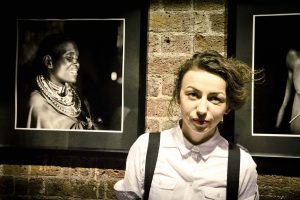
by Kim McCloskey | Aug 19, 2018 | About Storytelling, Featured
 Timpanogos Storytelling Festival is lucky enough to welcome back Clare Murphy, a self-described storyteller, performer, writer, dramaturg, curiosist, teacher, consultant, wanderer, wonderer and maker who has performed around the world. Her lilting Irish accent will remind you that her roots are from a country with one of the richest folktale traditions in the world. I was enchanted by Clare when she came to our festival a few years back and I’ve been excited to see her again ever since. We asked Clare to share some of her insights on her pathway to story.
Timpanogos Storytelling Festival is lucky enough to welcome back Clare Murphy, a self-described storyteller, performer, writer, dramaturg, curiosist, teacher, consultant, wanderer, wonderer and maker who has performed around the world. Her lilting Irish accent will remind you that her roots are from a country with one of the richest folktale traditions in the world. I was enchanted by Clare when she came to our festival a few years back and I’ve been excited to see her again ever since. We asked Clare to share some of her insights on her pathway to story.
Our theme this year is “Pathways to Story.”How would you describe your pathway to becoming a storyteller? Was it a road, a back alley, a fast track, or a meandering trail?
It was something between a back alley, a fast track and straying from the mainpath of life.
Could you tell us about someone who has influenced you on this journey as a storyteller?
My father was an actor, on the side. He didn’t do acting fulltime as it was the 70s and he had four kids. But I saw many of his performances, and got to go backstage and meet the actors. We would help him rehearse his lines and discuss the plays afterwards. My mother is a poet. Our house was filled with books of poetry and stories. She taught me much about how to appreciate language.
I was introduced to storytelling as a world by Liz Weir. She generously invited me to her home and allowed me to shadow her for three days. She went on to encourage me throughout the years to keep going and tell me about a lot of opportunities.
I was also influenced by John Moriarty, an Irish writer and storyteller. His deep connection to myth had a profound affect on me.
What are you passionate about outside of storytelling?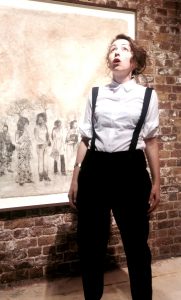
The planet and our responsibility as a part of Nature.
Kindness to each other and other species. I am passionate about art as a means of rehumanising us. I love dancing. and also chocolate, especially dark chocolate (70% + cocoa).
I love the joy of improvisation, the kindness of creativity.
Where does storytelling go from here? How do you see its influence on society?
Storytelling is exactly where it needs to be. It is in every pocket of the world. It has become a buzzword and its’ popularity is only growing. It influences society in every sphere: politics, art, climate change, education, love. People use story to support their ideologies. The hope is that the stories of love, tolerance, compassion, inclusion, kindness that bring together all human beings regardless of gender, politics or religion are the stories that will help us move forward.
What fictional place would you most like to visit?
Ursula K LeGuin’s EarthSea.
*************************************************************
Don’t miss
Clare at the 2018 Timpanogos Storytelling Festival September 6-8 at the Ashton Gardens at Thanksgiving Point in Lehi, Utah. For tickets and volunteer opportunities visit
timpfest.org.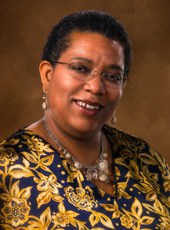
by Kim McCloskey | Aug 18, 2018 | About Storytelling
 Sheila Arnold doesn’t just tell stories; she lives them. As a professional historical character interpreter, Ms. Sheila takes on the role of historical characters and tells stories through their eyes. She has also written poems, stories, fiction, and plays, starting when she was in the seventh grade. With a life seeped in storytelling, Sheila enthralls her audience of students of all ages with her character portrayals, motivational speeches, workshops, and storytelling. You can also bet on her watching football and basketball when she has a chance to, and working with youth and reading legal mysteries are also up there on her list of interests. A woman with a wide range of talents, interests, and abilities, Sheila’s storytelling is certainly one to experience.
Sheila Arnold doesn’t just tell stories; she lives them. As a professional historical character interpreter, Ms. Sheila takes on the role of historical characters and tells stories through their eyes. She has also written poems, stories, fiction, and plays, starting when she was in the seventh grade. With a life seeped in storytelling, Sheila enthralls her audience of students of all ages with her character portrayals, motivational speeches, workshops, and storytelling. You can also bet on her watching football and basketball when she has a chance to, and working with youth and reading legal mysteries are also up there on her list of interests. A woman with a wide range of talents, interests, and abilities, Sheila’s storytelling is certainly one to experience.
We had the privilege of asking Sheila a few questions, and we have her answers for you in our interview below. We’re excited for you to get to know Ms. Sheila better before the Timpanogos Storytelling Festival begins, so without any more preamble, we present to you an inside look at Sheila Arnold.
Q&A with Sheila Arnold
Our theme this year is “Pathway to Story.” How would you describe your pathway to becoming a storyteller. Was it a road, a back alley, a fast track, or a meandering trail?
My pathway to story has been a rambling road with dead ends and no outlets, and then an autobahn. I have been telling stories since I was a kid, and was on the Forensics team and in Drama in high school and my first year of college. Then all my performance stuff stopped! I came back to storytelling when my son was in his second daycare and I was working a job that allowed me to come and tell stories at his day care facility. From there my name was given to others, I presented in each of my son’s classes, and finally arrived at Colonial Williamsburg Foundation (VA) where I became a paid storyteller in their evening programs. That is where the autobahn came. I was strongly encouraged to do more and more storytelling and in 2003 I left my full-time job to be full-time, self-employed professional storyteller. There was a bit of a storm on the road where I had to pull over in late 2003 and early 2004, but after the storm passed, it’s been wide open road. I love my job, and at each rest stop along the way, I get to meet more people, learn new things and am given new challenges for the road ahead.
Could you tell us about someone who has influenced you on this journey as a storyteller?
My son is my greatest fan, and I started everything because of him. When I left my full-time job, he was a senior in high school. I talked to him first and told him that his senior year might be seriously financially impacted, and my son looked at me and said, “Mom, this is the job you were always meant to do. We’ll be okay.” And with that love, and my parents’ love and initial financial assistance, I am doing the job I was always meant to do and the everything is okay.
In the storytelling community there are so many stories of folks who have helped, but it would be my friend, Mary Lovell from Kentucky, whose words of belief that I was a storyteller worth hearing, worth seeing on a national stage, worth having a CD made, she would be that push that led me to go further than I ever would have thought.
When I first started storytelling, I wanted to “grow up to be like” Charlotte Blake Alston, and she told me it was okay to be myself. Diane Ferlatte took me under her wing to help me know there was more to storytelling than being at festivals. In regards to my personal stories, which was not how I began storytelling: Donald Davis began the process of looking at personal stories; Milbre Burch encouraged me to express my stories better; Susan Klein helped me explore the depth of my stories, and Susan O’Halloran helped me to believe my stories needed to be told.
What are you passionate about outside of storytelling?
Faith and Justice are a focus of much of my storytelling, but also what I am passionate about outside of storytelling. My faith, as a Christian, is to grow in my relationship with God and to share the hope of Christ with others through words and mostly through action. I am also passionate about justice and speaking up and out about places where we as people, as a community, and as a country can and should be better. I love teaching parents and teachers. I am adamant about history and getting history to people, and learning from history. I am passionate about my grandson, Brooklyn, six years old and has stolen my heart away. And I LOVE to read. I am not a fast reader but I usually have 2-3 books going on at a time.
Where does storytelling go from here? How do you see it’s influence on society?
Storytelling is absolutely essential. I have seen the power of a story change the life goals of a person, awakening in them a hope or a dream that they never had. I have seen my stories allow people to grieve, to want to live, to decide they will be a part of the change in our society. I believe stories teach and inspire us, and we need so much more. I think historical storytelling needs to be happening more and more, allowing us to really hear the stories of the past.
I do think that sometimes our stories are too focused on the personal, which really only have one cultural basis and are good for a limited time, before you have to explain too much of the story because times change. However, folk tales (and fairy tales) are cross-cultural and cross-time frame (“Once upon a time”), and should be encouraged, as well as used and modified for us today. The more stories we tell, the more time we spend talking with one another. We need more of that.
What fictional place would you most like to visit?
Narnia!
**************************************************************************************************
Come see Sheila at the 2018 Timpanogos Storytelling Festival on September 6-8 at the Ashton Gardens at Thanksgiving Point in Lehi, Utah. Tickets are available at timpfest.org.
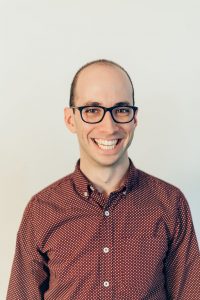
by Kim McCloskey | Aug 17, 2018 | About Storytelling
 Blending traditional mountain folklore with music and the contemporary Appalachia, Adam Booth’s approach to storytelling tickles the funny bone and tugs at heart strings. With myriad appearances at a host of storytelling festivals and events (including the National Storytelling Festival), and a plenty of awards to adorn his biography and proverbial trophy case (such as four Storytelling World Awards and Honors), Adam not only tells stories, but also teaches Appalachian Studies at Shepherd University, and is the founding director of the Speak Story Series. Oh, and let’s not forget his four championship wins at the West Virginia Liar’s Contest (makes you think about his accolades, doesn’t it?).
Blending traditional mountain folklore with music and the contemporary Appalachia, Adam Booth’s approach to storytelling tickles the funny bone and tugs at heart strings. With myriad appearances at a host of storytelling festivals and events (including the National Storytelling Festival), and a plenty of awards to adorn his biography and proverbial trophy case (such as four Storytelling World Awards and Honors), Adam not only tells stories, but also teaches Appalachian Studies at Shepherd University, and is the founding director of the Speak Story Series. Oh, and let’s not forget his four championship wins at the West Virginia Liar’s Contest (makes you think about his accolades, doesn’t it?).
Before the Timpanogos Storytelling Festival gets underway, get to know Adam Booth better by taking a look at this exclusive interview we were privileged to have with him. While it’s true that he is an amazing liar, his insight is deep and his experiences inspiring. We’re pleased to be able to let you in on some of his thoughts on storytelling, life, and more. Ladies and gentlemen—Adam Booth.
Q&A with Adam Booth
Our theme this year is “Pathway to Story.” How would you describe your pathway to becoming a storyteller. Was it a road, a back alley, a fast track, or a meandering trail?
I would call my pathway a forest trail that meanders up and down through the woods, over the springs, and around the rocks, with some difficult climbs, beautiful overlooks, and plenty of good company in the fellow hikers on the way.
Could you tell us about someone who has influenced you on this journey as a storyteller?
In 2011 I received the NSN J. J. Reneaux Mentorship Grant to begin a mentoring relationship with Dovie Thomason. This was a major step for me as a teller and I feel like I experienced tremendous growth in the years immediately following. Even though the grant was for one year, we have continued our relationship. Dovie has been along my journey ever since then, and I am excited to share the stage with her at Timpanogos. This will be the very first time we have told at an event together.
What are you passionate about outside of storytelling?
I am an advocate for correcting perceptions of Appalachia and Appalachians, which actually comes through a lot of my storytelling. I’m also passionate about youth education. Again, this is very much part of my work, so, perhaps those doesn’t count. I enjoy hiking and camping wherever I go, but especially in the West Virginia hills.
Where does storytelling go from here? How do you see it’s influence on society?
Storytelling is a hot word right now and we see and hear it combined with other media and processes, such as storytelling and health, or storytelling and community building. From here we work to see a greater general understanding of storytelling and how it touches all disciplines, not just as a hyphenated addition.
What fictional place would you most like to visit?
Mr. Roger’s Neighborhood.
http://www.adam-booth.com/
Thanks Adam! To see him live at this year’s Timpanogos Storytelling Festival on September 6-8, 2018 at the Ashton Gardens at Thanksgiving Point in Lehi, Utah go the our website to buy tickets at https://timpfest.org/
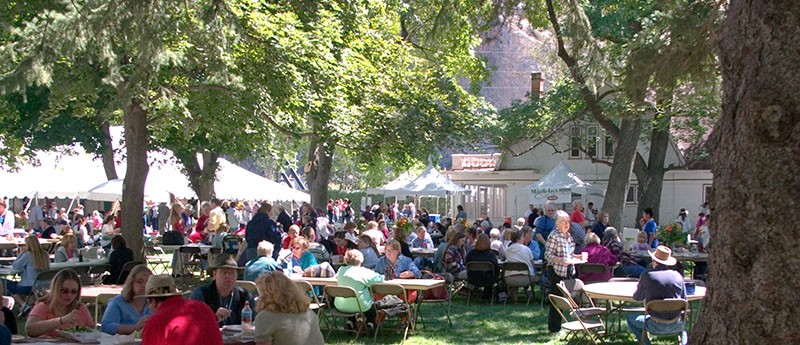
by Kim McCloskey | Aug 15, 2018 | About Storytelling, Benefits of Storytelling

A couple of weeks ago, a friend said to me, “Haven’t you been with the Timpanogos Storytelling Festival since the start? Why?” I stammered for a few moments and finally gave a pretty lame answer, “I just really like it.”
Now that I’ve thought about it for a while, I’d like a do-over—you know, a second chance to answer and maybe sound like a grown up. I have attended every Festival, and have worked on the committee, in some capacity for 28 of its 29 years. If you’re doing something for that long, you better have a really good reason—or two.
When the Festival began, I was a young mother juggling an 11-year old, a 9-year old, and 2-year old twins. I was swamped with the everyday work of raising a family and I was losing myself somewhere between the laundry and the dirty dishes. My good husband saw an article in the newspaper about an event in the Ashton’s yard and offered to take a day off so we could go. My mother watched the twins for us and on a sunny August Friday morning in 1990, we went. As I sat in the front row, storyteller Judith Black told a story I can repeat to this day about a rabbi who, when faced with accounting for his life, was chastised because he had not become his own true self.
The story was, for me, like a shaft of light from above. Becoming my own true self! That concept changed my perspective, my goals, my outlook on life. I had to be a part of this, this . . . group of people. Storytellers? Well, whatever. This is where I belonged. So I volunteered.
As my children grew, so did my involvement. The children began to hear the stories as we came as a family. It became Our Annual Event. We referred to it simply as ‘The Festival.’ Our family lexicon referenced stories we had heard together like other families reference movie quotes. We talked about storytellers as if they were part of our extended family. We quoted them, we sang 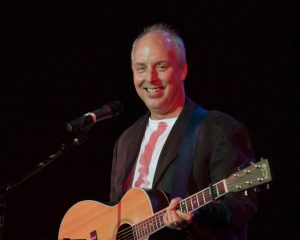 their songs (thank you so much, Bill Harley, for “Black Socks!”), we laughed at their jokes again and again and learned about other perspectives and cultures. Slowly and surely, the stories provided a safe framework for our family discussions and conversations.
their songs (thank you so much, Bill Harley, for “Black Socks!”), we laughed at their jokes again and again and learned about other perspectives and cultures. Slowly and surely, the stories provided a safe framework for our family discussions and conversations.
And the children grew up. They tend to do that. Without my permission, they became teenagers. Who wants to go to a storytelling festival when you’re a teenager? They did! Who knew? They brought friends and they’d take off, listening to stories and finding their own adventures. At the end of the first day of stories, we’d compare notes and plan our schedules for the next day.
Then they had the nerve to grow up and leave home. What were they thinking? But guess what happened? They came back. First with boyfriends (we have four daughters), and then with husbands who have also learned to speak Storytelling. And now, even grandchildren. Three generations of us speak Storytelling and reference story quotes like other families reference movies.
So, why have I stayed with the Timpanogos Storytelling Festival for 29 years? Why have I faithfully followed from the Ashton’s yard, to the Olmsted, to Mt. Timpanogos Park, to Thanksgiving Point? Because of family—the family I have raised, and the family I have gained through these annual “family reunion” storytelling festivals. I belong here—these are my people; my tribe, if you will. The people who are willing to put down the electronic screens, look in human faces, and hear hearts speaking. People who will sing along with strangers, laugh with people they’ve never met, and cry a little sometimes with someone who is just about to become a friend. People who will talk to others in line, people who will help just because, and people who are storytellers both onstage and off. I come back, I volunteer, I look forward to The Festival because it is family—that “sittin’ on the front porch with yore folks” feeling that is so strong no matter where The Festival is held. Because of love and family, frankly. Well, that and the peaches and ice cream!
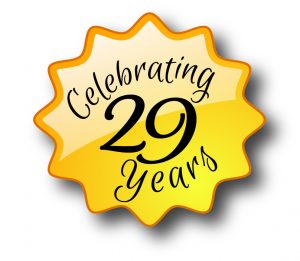
Join us at the 29th annual Timpanogos Storytelling Festival September 6-8 at the Ashton Gardens at Thanksgiving Point in Lehi, Utah.
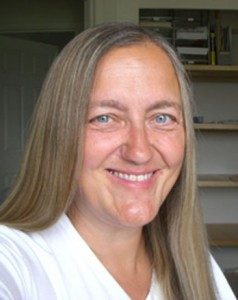
by Kim McCloskey | Aug 12, 2018 | About Storytelling
 I was privileged to meet Terri McGuire while she was teaching at the former Meridian School in Provo and I just can’t say enough about what an amazing teacher she is. Her classroom was truly a magical place. Each school year began with a trip to the Timpanogos Storytelling Festival, and now retired after nearly 40 years, this award-winning teacher tells us how she first became a fan of the festival and how she used her experience to create memorable teaching and learning moments in the classroom.
I was privileged to meet Terri McGuire while she was teaching at the former Meridian School in Provo and I just can’t say enough about what an amazing teacher she is. Her classroom was truly a magical place. Each school year began with a trip to the Timpanogos Storytelling Festival, and now retired after nearly 40 years, this award-winning teacher tells us how she first became a fan of the festival and how she used her experience to create memorable teaching and learning moments in the classroom.
*************************************************************************************
Terri McGuire
In late August of 1990 our family had just moved to American Fork, Utah. My children were starting elementary school, my husband was embracing a new career as a pipe organ builder, and I had found a part-time teaching job. This left me with a bit of time on my hands to explore this interesting new place we were living. I’ve always enjoyed stories, arts, and history, so I often found myself wandering into local libraries. 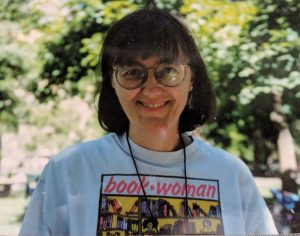
When I walked into the Orem Public Library one morning I saw advertisements for the second annual Storytelling Festival to be held at Ashton Gardens and asked the librarian to tell me more. She said the money they earned from the event was going to help the library rebuild the children’s section of the library. This sounded like a wonderful mix of the things I enjoy most! I knew I wanted to attend, but the first day of the festival was a school day, so I went by myself.
I had experience with storytelling, and thought I understood what I would experience. I’d been a Girl Scout and native legend storyteller as a youth. I’d used folk tales and storytelling a bit in my classroom to teach. And, I had grown up in a family that loved telling their history stories. I planned on having a fun time.
What I didn’t know was how deeply this event would move me. I was totally unprepared for the depth of feeling, the love of story, the sense of community, and the celebration of truly gifted tellers. I heard traditional stories, song stories, history stories, family stories, ghost stories, humorous stories, and folk tales. Jugglers, musicians, puppeteers, and performers added to the experience. I was amazed, and I was hooked!
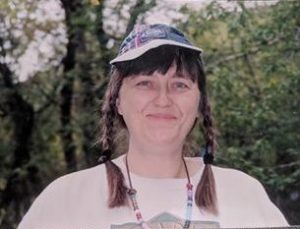 Even though I was still a newcomer to Utah and I attended alone, for that afternoon I had the feeling of coming home. I was part of this storytelling experience. You do not just listen to a story of this caliber. The audience is required to participate with mind and emotions, living the story along with the teller. I found that when the teller was done, the story wasn’t over for me. Those tellers of tales had touched me deeply, because their stories had merged with my life stories.
Even though I was still a newcomer to Utah and I attended alone, for that afternoon I had the feeling of coming home. I was part of this storytelling experience. You do not just listen to a story of this caliber. The audience is required to participate with mind and emotions, living the story along with the teller. I found that when the teller was done, the story wasn’t over for me. Those tellers of tales had touched me deeply, because their stories had merged with my life stories.
The next day, I brought my children to the storytelling festival. By the next year, I had a full time teaching position and started bringing my students each year to the festival. Stories allow us the chance to understand how connected we are. They help us to understand how to speak, to write, know our place in history, to share feelings and what is important to us.
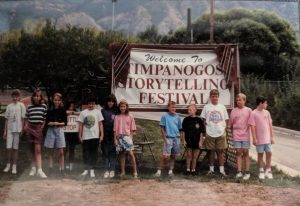
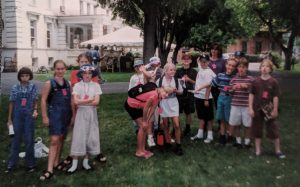
Over the years, I have incorporated storytelling into my classroom in a variety of ways. After a day-long visit to the storytelling festival, where we heard the wonderfully told stories of others, we began each school year by telling each other our own stories. Our personal history and family histories have roots in our cultural heritage and give us the power to connect with others. This created interpersonal connections in our classroom, which were akin to a strong handshake and helped us to understand each other much better.
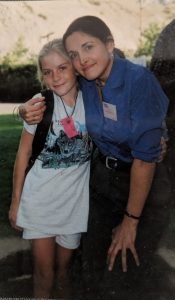 Listening to masterful storytellers tell their tales via CD or video, gave us a combined cultural experience of storytelling. Different storytellers demonstrated their talents for us over many days and through many tales. We identified a list of skills and practices of good storytellers, which we used as touchstones for creating our own interpretations and connections to what we were studying. Storytelling allowed us to think deeply about those critical skills. We learned to incorporate and consider such as things as: audience, voice, facial expressions, body movement, music, pauses, tone, etc. to better share our message.
Listening to masterful storytellers tell their tales via CD or video, gave us a combined cultural experience of storytelling. Different storytellers demonstrated their talents for us over many days and through many tales. We identified a list of skills and practices of good storytellers, which we used as touchstones for creating our own interpretations and connections to what we were studying. Storytelling allowed us to think deeply about those critical skills. We learned to incorporate and consider such as things as: audience, voice, facial expressions, body movement, music, pauses, tone, etc. to better share our message.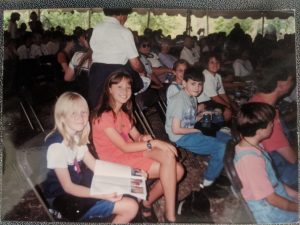
Some of the specific activities we experienced that were enhanced by storytelling were:
Students practiced storytelling skills and presented earliest memory stories and personal favorites at a storytelling sleepover at our school.
We incorporated family stories and cultural connections into a Cultural Fair presentation. Through cross-generation interviews and research, students discovered their personal connection to family and history. These personal stories became the basis of comparison for all the other stories we encountered during the year.
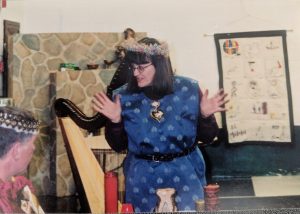 In October, we began our study of ancient civilizations, we searched for and shared likely stories based on location of artifacts we found in an archeology dig.
In October, we began our study of ancient civilizations, we searched for and shared likely stories based on location of artifacts we found in an archeology dig.
When we retold stories of mythology and historical events, students created freeze-frame tableaus, Instant character reenactments, and told the story from different points of view.
We created “This is Your Life” game show presentations of personal stories of Civil War celebrities, and a “Walk Through Time” historical museum, where students retold the stories of important people in history.
Students created storytelling math problems with optional solutions. More than a word problem, these were designed to tell the whole story and highlight a math concept.
For reviews, we created current-day newscasts, newscasts from the past, podcasts, cartooning summaries, puppets shows, plays, picture books, and photo essays to demonstrate connections and retell the essence of a story.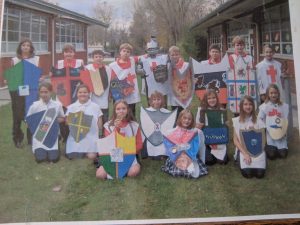
We hosted a Renaissance guild fair, a Medieval banquet, and a Civil War battle reenactment to inform our school community and adults about the culture, stories, and characters of these times in a retelling of what we had learned.
As we explored the aspect of Voice in writing, we asked questions like “What would Donald Davis do?” “How would Bill Harley write this?” In other words, “Can I see this from another perspective?” “Can I make it better?”
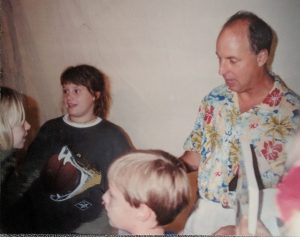 As the year progressed, we found ourselves continually finding new reasons to tell stories and use these skills. I believe it helped my students to find deeper, more meaningful connections to what we studied. We all participated fully in the story our class was creating, because storytelling gave us all a voice, gave us all permission.
As the year progressed, we found ourselves continually finding new reasons to tell stories and use these skills. I believe it helped my students to find deeper, more meaningful connections to what we studied. We all participated fully in the story our class was creating, because storytelling gave us all a voice, gave us all permission.
I am now retired, but still love coming to the festival. My husband attends with me and enjoys it as much as I do. The hardest part for us is trying to figure out whether we should revisit our favorite tellers to hear stories that warm our hearts and make us laugh, or whether we should try for a new adventure with a teller we haven’t yet met. We are always entertained, always feel warmly welcomed, always participate with abandon, and are left with memories that touch our hearts and a lingering sense of wonder.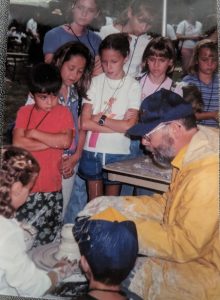

 Timpanogos Storytelling Festival is lucky enough to welcome back Clare Murphy, a self-described storyteller, performer, writer, dramaturg, curiosist, teacher, consultant, wanderer, wonderer and maker who has performed around the world. Her lilting Irish accent will remind you that her roots are from a country with one of the richest folktale traditions in the world. I was enchanted by Clare when she came to our festival a few years back and I’ve been excited to see her again ever since. We asked Clare to share some of her insights on her pathway to story.
Timpanogos Storytelling Festival is lucky enough to welcome back Clare Murphy, a self-described storyteller, performer, writer, dramaturg, curiosist, teacher, consultant, wanderer, wonderer and maker who has performed around the world. Her lilting Irish accent will remind you that her roots are from a country with one of the richest folktale traditions in the world. I was enchanted by Clare when she came to our festival a few years back and I’ve been excited to see her again ever since. We asked Clare to share some of her insights on her pathway to story.

















